Eating a balanced diet means incorporating lean proteins, good complex carbs, an abundance of veggies, and the natural sweetness of fruit to your meals.
Fruit, aka nature’s candy, makes up one of the healthiest and most delicious food groups. It’s one of the first swaps I tell my clients to make when they’re trying to regulate excess sugar in their diets.
Even though fruit has natural sugars, it’s still way better for you than the dangerous amounts of sugar found in processed foods.
What’s the difference?
Fruit brings more to the table than what refined sugar offers up.
All fruit is low in calories and sodium, packed with fiber, vitamins, nutrients, magic – ok, maybe not magic, but it sure seems like it. I mean fruit tastes better than junk food and it’s healthy for you; sounds pretty magical to me.
Fruit also has zero cholesterol, which is pretty cool considering that eating more fruit has been associated with a reduced risk of heart disease. In fact, your chances of developing heart disease decrease by 7% for every daily serving of fruit you eat.
That’s reason enough to start loading up on fruit!
So if fruit really is this amazing, can we ever eat too much of it? Are there any downsides to eating too much fruit?
The Greatness that is Fruit
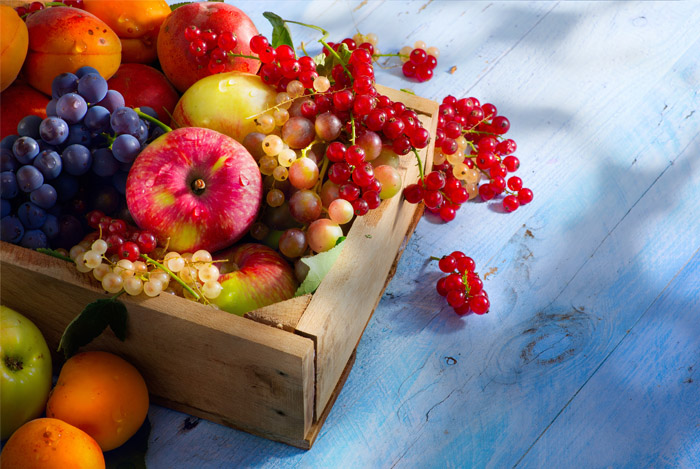 According to one study “92.4 percent of us don’t hit our fruit target”.
According to one study “92.4 percent of us don’t hit our fruit target”.
If you’re following a low carb diet or a keto diet plan, I doubt you’ll be adding lots of fruit to your meals. You’re probably aiming for 20–40 g of carbs and simple fruits such as apples and bananas may contain over 20 g of carbs in one serving.
But excluding fruit seems crazy to me so I always make room for it in my carb counts. You just can’t beat the benefits.
Fruit is packed with potassium, vitamin C, phytochemicals, and folate to help lower blood pressure, keep our immune systems healthy, and even keep cancer away.
Plus, according to one review of over 150,000 women and 36,000 men without chronic diseases, a “greater consumption of whole fruits – especially blueberries, grapes, and apples” was “associated with a lower risk of type 2 diabetes”.
One of my favorite reasons for loading up on fruit (besides satisfying my sweet tooth) is dietary fiber.
Did you know that the average adult only gets 15 g of fiber every day, despite us needing between 21-38 g of daily fiber?
The dietary fiber in fruit:
- Reduces cholesterol levels
- Lowers risks of heart disease
- Promotes proper bowel function
- Reduces diverticulosis
- Provides a feeling of fullness so we don’t overeat
- May reduce the risk of obesity and type 2 diabetes
You’ll enjoy the most fiber when you eat your fruit with the skins on. Watermelon rinds, banana peels, and kiwi skins are all edible options to the standard apple, pear, or peach skin.
So What’s So Bad About Fruit?!
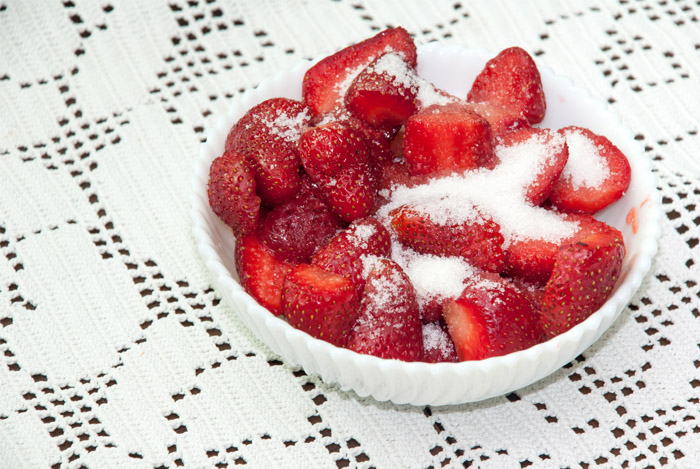 If fruit is as great as I’ve been praising, can we gorge on fruit baskets and dance around like Carmen Miranda every day?
If fruit is as great as I’ve been praising, can we gorge on fruit baskets and dance around like Carmen Miranda every day?
Well, just like most modern day food issues, it all boils down to one thing: sugar.
Sugar comes in several forms such as glucose, sucrose, and fructose.
Sucrose, well, that’s just regular old table sugar. It’s a combination of glucose and fructose.
Glucose is what our body uses as fuel to perform. This source of energy powers everything from the cells in our organs to our muscles and our working brains. We typically get glucose from breaking down carbs.
“Simple carbohydrates are broken down quickly by the body to be used as energy. Simple carbohydrates are found naturally in foods such as fruits…They are also found in processed and refined sugars such as candy, table sugar, syrups and soft drinks”.
Both glucose and sucrose get metabolized in our bloodstreams.
When glucose and sucrose are broken down and digested, they’re processed so fast that it causes your blood sugar levels to rise. Then your pancreas has to work double time to produce enough insulin to combat the flood of excess sugar in your system.
Having too much glucose in your blood causes high blood sugar levels, which can lead to insulin resistance, type 2 diabetes, and health issues such as PCOS, obesity, and heart disease.
This typically happens when you snack on refined carbs instead of good complex carbs because simple carbs usually lack the fiber that keeps your blood sugar levels stable.
But there’s plenty of fiber in fruit to slow that process down, so fruit should be ok to eat in excess, right?
Not exactly.
Fructose, the kind of sugar found solely in fruit, behaves much differently in our bodies than the other types of sugar. Fructose is primarily metabolized in our livers.
However, if your liver already has enough in the way of energy stores, “your liver turns any excess sugar intake into triglycerides that get stored in fat cells throughout the body”, says Brigitte Zeitlin, MPH, RD, CDN.
When you gorge on fruit without a fructose-starved liver situation, you’ll develop unwanted fat deposits around your belly. This particular type of visceral belly fat is also linked with type 2 diabetes.
As you can see, too much of a good thing definitely has its drawbacks, so moderation is key.
Speaking of which…
Do You Know What a Serving Size of Fruit Looks Like?
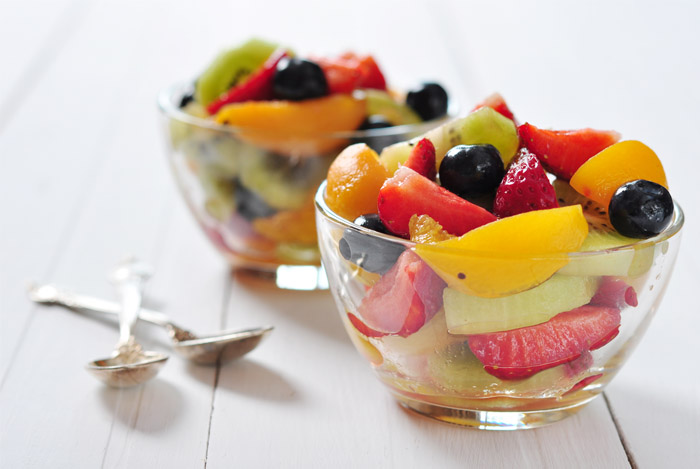 Your daily fruit requirement is actually pretty low in my opinion, coming in at 1.5 to 2 cups of fruit per day depending on your gender.
Your daily fruit requirement is actually pretty low in my opinion, coming in at 1.5 to 2 cups of fruit per day depending on your gender.
But if you work out more, you can definitely up your fruit intake and stay well within your calorie and carb goals.
It’s easy to keep track of your fruit servings if you cut up your fruit and measure it out, but most of us don’t have time to do that every morning so we run out the door with a banana under one arm and an apple balancing on our head.
So what does one cup of fruit look like?
- 1 small apple
- 1 large banana
- 1 medium grapefruit
- 32 average sized grapes
- 1 large orange
- 1 large peach
- 1 medium pear
- 2 large plums
- 8 large strawberries
If you follow these guidelines, you could eat one banana in your morning overnight oats and one medium pear after lunch and be completely done with your two cup fruit requirement. That’s almost too easy.
And too easy to overdo!
According to the USDA, if you’re eating more than these two cups of fruit every day, which is not far-fetched if you love ripe seasonal fruit, you’re eating too much fruit.
This daily fruit serving is especially easy to overlook if you’re addicted to smoothies, not the kind with over 60 g of sugar, but homemade ones full of wholesome ingredients and zero added sugar.
You guys know I’m a big fan of smoothies, especially if I throw a bit of whey protein or hemp protein into the mix to repair my muscles after my AM workout, and to give me sustained energy levels for the rest of the day.
But be careful about how much fruit you’re adding to your smoothies since it’s very easy to go over your recommended daily intake. Always measure out exactly how much fruit you throw into that bottomless blender.
Remember: one banana and one orange in your smoothie taps out your entire fruit budget in one sitting.
Does Fruit Juice Count?
 The USDA says yes; one cup of fruit juice counts the same as one cup of fresh fruit.
The USDA says yes; one cup of fruit juice counts the same as one cup of fresh fruit.
But I have to disagree here (cue gasp).
Fruit juice can have just as much sugar as what’s found in popular sodas. For example, Minute Maid 100% apple juice has a whopping 65.8 g of fructose per liter.
Want to know what’s in Pepsi and Coca Cola?
Both of them come in at lower fructose levels of 65.7 g and 62.5 g of fructose per liter, respectively.
“The human body isn’t designed to process this form of sugar at such high levels”, says Michael Goran, the director of the Childhood Obesity Research Center at the University of Southern California.
You have to be careful about added sugars in juice – fruit is sweet enough and doesn’t need it. Check the labels and stay away from anything with HFCS.
Be wary of juice labeled as “No sugar added”. Even though the sugar may come directly from the fruit, it’s a super concentrated amount, devoid of the fiber found naturally in whole fruits.
Since juice lacks this fiber, when you drink it, all of that sugar spikes your blood glucose levels and sends you on a one-way train to Fat Deposit Town. There’s no fiber to slow its digestion down in your system.
According to one study, eating more whole fruits was associated with “a lower risk of type 2 diabetes”, but consuming more fruit juice was associated with a “higher risk of type 2 diabetes”.
If you need to have your morning glass of orange juice, just water it down a bit. Start with a 70% juice to water ratio and see if you can steadily reduce it so you’re mitigating all that unnecessary sugar.
Speaking of diabetes…
Should Diabetics Eat Fruit?
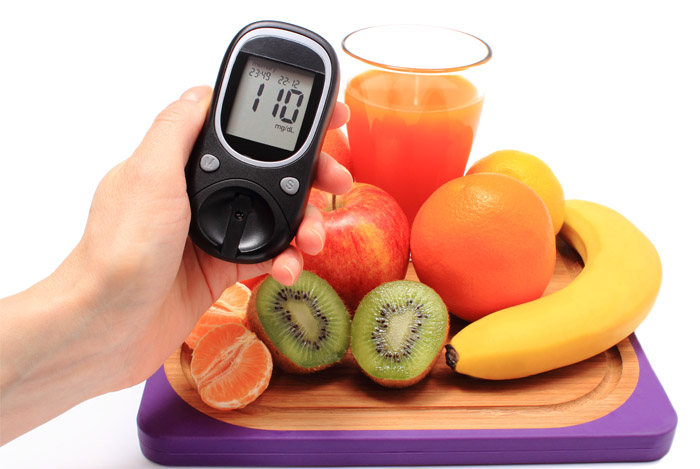 Chances are you’re already paying attention to the sugars and carbs in your food if you’re prediabetic or suffering from type 2 diabetes.
Chances are you’re already paying attention to the sugars and carbs in your food if you’re prediabetic or suffering from type 2 diabetes.
You can use both the glycemic index and the glycemic load measurements to add the least blood-sugar-spiking foods to your fruit-filled life as long as you swap out some other carbs.
Managing diabetes is all about curbing your sugar intake and counting carbs (which turn into sugar and upset your blood levels).
The glycemic index measures how much the carbs in food affect blood sugar levels. Foods with high GI scores (GI 70+) raise your blood sugar levels and foods with low GI scores (GI 55 or lower) will keep your blood sugar relatively stable.
The glycemic load is a measurement that uses the glycemic index to calculate the amount of carb-based sugar in a single serving. A score under 11 is very low, anything over 20 is considered high in sugar.
So for example, watermelon is a 72 on the glycemic index, which is pretty high. However, there’s only 5 g of carbs in a typical serving size of watermelon. After calculating the glycemic load, watermelon comes in at a very low 3.6.
Using both of these measurements will give you an idea of which fruits to choose over others.
Some good options for diabetics include:
- Berries
- Cherries
- Peaches
- Apricots
- Apples
- Oranges
- Pears
- Kiwi
Just keep in mind that you still have to count the carbs in fruit. Just because the sugar found in fruit is natural and healthier doesn’t mean you should eat too much of it.
Fruit Pairings – They’re More than Fancy H’dourves
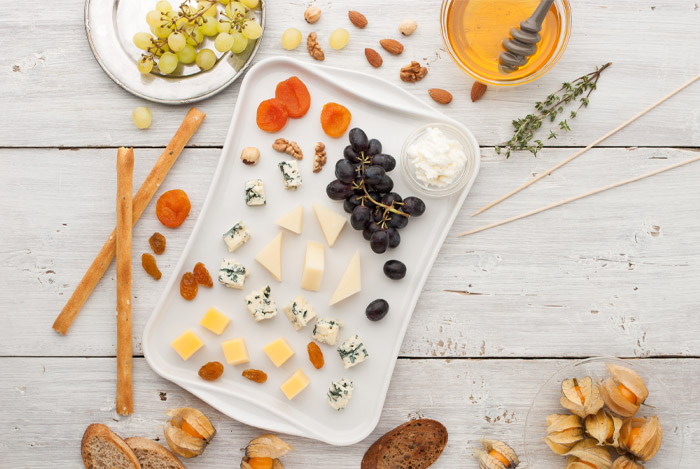 Nut, fruit, and cheese platters aren’t just for your wine tasting nights, they’re actually a super healthy combination of protein and carbs.
Nut, fruit, and cheese platters aren’t just for your wine tasting nights, they’re actually a super healthy combination of protein and carbs.
Protein takes longer to digest than quick digesting carbs. So the protein in cheese and the fiber in nuts helps to slow down the rate at which the sugars from the fruit get processed and absorbed by your body.
Some of my favorite fruit and high protein snacks include:
- Cottage cheese and berries
- Bananas and almond butter
- Apples and Swiss cheese
- Watermelon and feta cheese
- Strawberries and almonds
- Figs and goat cheese
- Grapes and sharp cheddar
- Greek yogurt parfait with raspberries, blueberries, and walnuts
Fruit combinations are also being reviewed for their effect on insulin regulation.
In one surprising study, researchers asked healthy women to consume either different types of berries or a mixed berry puree with slices of white bread.
The scientists wanted to know if the berries would delay the white bread’s tendency to spike blood sugar levels because “polyphenol-rich berries may reduce digestion and absorption of starch”.
The results were a bit mind-boggling.
When strawberries, bilberries, lingonberries, chokeberries, and the mixed berry puree were consumed with the white bread, the effects of glucose metabolism were “slightly improved”.
The scientists also discovered that the berries made it possible for the subjects to use less insulin to process the carbs and sugars just as effectively.
While further studies are definitely needed, this may prove that fruits such as antioxidant-rich berries can mitigate the effects of a poor simple-carb fueled diet.
Final Notes
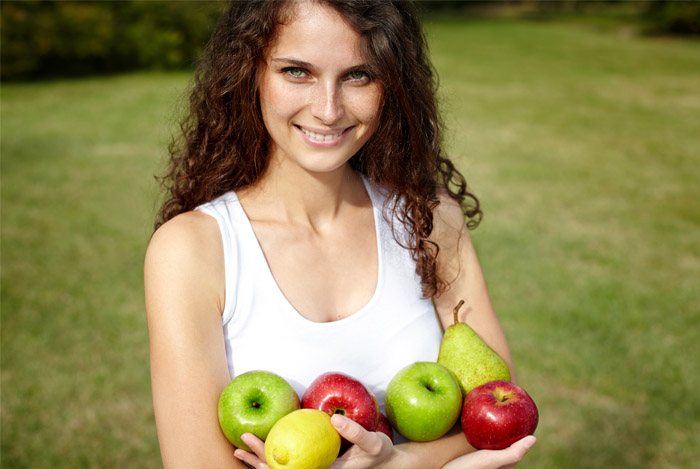 If the statistics are to be believed, most of us aren’t eating enough fruit even though the recommended daily intake requirement is so low.
If the statistics are to be believed, most of us aren’t eating enough fruit even though the recommended daily intake requirement is so low.
I’ll admit it, I definitely eat more fruit than I’m technically allowed to have. But I also work out a lot, choose complex carbs, and stay away from processed, sugary junk food.
I don’t think the two cups of fruit rule should scare you off from enjoying nature’s candy as part of a healthy diet. As long as you’re replacing bad carbs and processed sugars with the good ones found in fruit, you shouldn’t have a problem.
Now if you’re throwing handfuls of fruit into your blender with reckless abandon, snacking on super sweet dried fruits all day, and eating banana splits every night, you’re going to be in trouble.
Are you eating too much fruit? What’s your opinion on the 2 cups a day rule? Share your fruity thoughts with me in the comments!
The post How Much Fruit Should You Eat Every Day? appeared first on Nutrition Secrets.
http://www.nutritionsecrets.com/how-much-fruit-to-eat-daily/
No comments:
Post a Comment